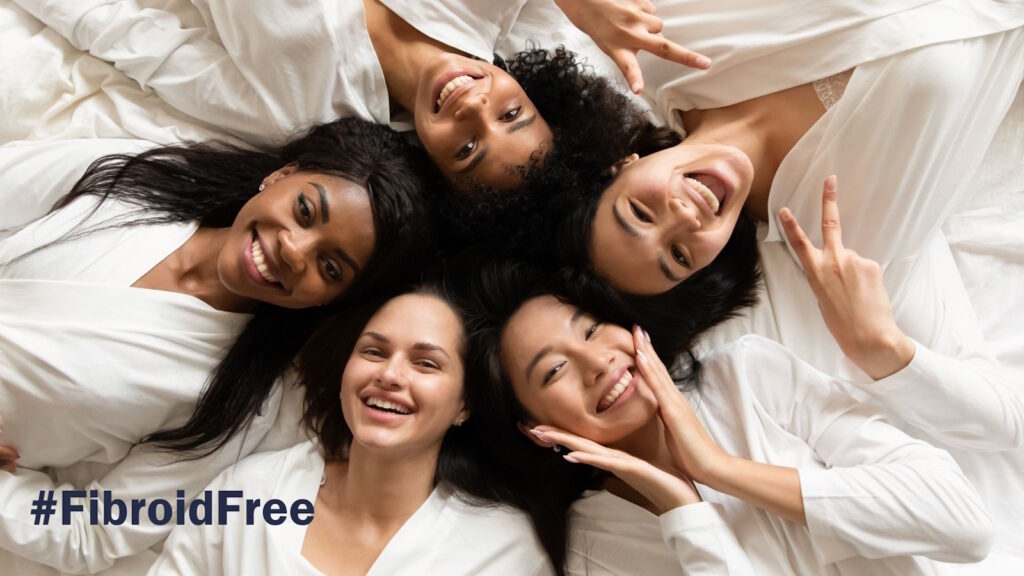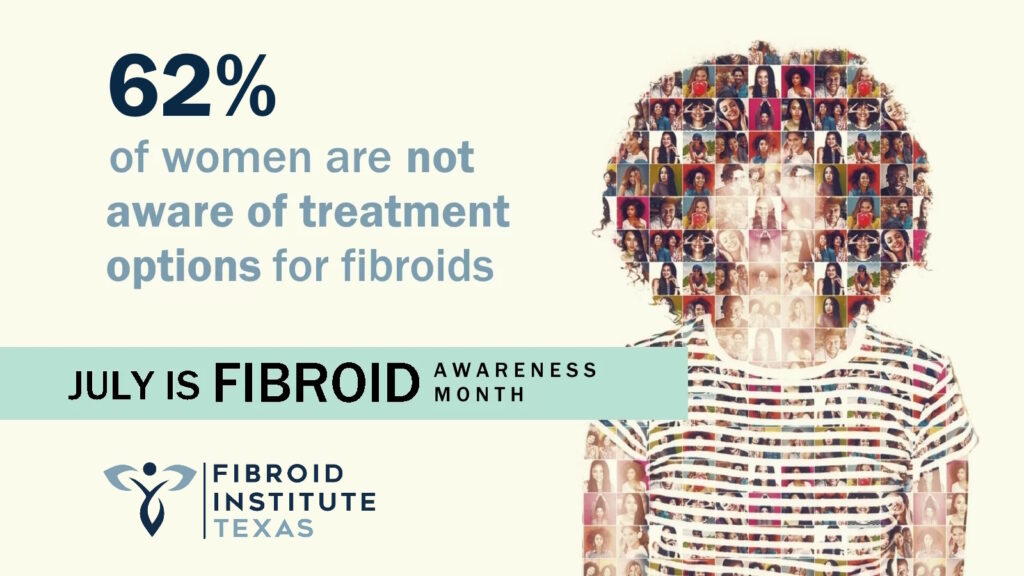Exciting news: July is Uterine Fibroid Awareness Month in Texas! Now in its second official year, this initiative was created to draw continued attention to uterine fibroids, a condition that challenges millions of women worldwide. Fibroid Awareness Month is also intended to bring communities together throughout the state for self-care and awareness events while spurring additional research and funding for this common but often under-discussed condition.
At Fibroid Institute Texas, we agree it is important to educate women through critical awareness efforts such as this, all while being at the forefront of a non-invasive treatment option that allows fibroid patients to get back to enjoying life. This is one reason our founder and medical director, Dr. Suzanne Slonim, was instrumental in bringing this important topic to legislative members two years ago.
In 2021, State Representative Senfronia Thompson presented legislation for Texas House Bill 1966–designation of July as Uterine Fibroids Awareness Month and House Bill 1967–Improved Uterine Fibroid Education and Research. Texas Governor Abbott passed both bills. As a result, Texas became the 9th state to have an officially designated uterine fibroids awareness month. To raise awareness of fibroids as the most prevalent and costly health issue affecting women in North Texas, the Dallas City Council joined two U.S. Cities and nine U.S. states in declaring July Fibroid Awareness Month as well.
Uterine Fibroids Are a Bigger Problem Than You May Think
Research estimates that 171 million women worldwide suffer from uterine fibroids. These noncancerous growths of the uterus often appear during childbearing years, affecting 70-80% of all women between 35 and 54. While some women don’t experience any symptoms, many do. Some of the more common debilitating symptoms include:
- Painful periods, including heavy or inconsistent menstrual bleeding
- Cramps, pelvic pain, and pressure
- Bloating or swelling in the lower abdomen
- Back or leg pain
- Bowel or bladder dysfunction
- Constipation, diarrhea, and rectum discomfort
- Anemia, which can lead to fatigue
Each year in the United States, almost $8 billion is spent on obstetric outcomes attributed to fibroids. Uterine fibroids cost women in the U.S. more than $17 billion annually through absenteeism and short-term disability. This includes Black and Asian women. In fact, 80% of Black women develop fibroids by the time they are 50, compared to 70% of white women.
The lack of dialogue and misinformation that exists has only contributed to women feeling unprepared for the journey ahead and uneducated about their options. Many women are not aware they have fibroids, don’t have access to adequate information or treatment, are hesitant to report, or normalize their symptoms as being a woman. In fact 62% of women aren’t aware of treatment options for fibroids and one in five women believe the only treatment is hysterectomy.
The Impact of Fibroid Awareness Month is Undeniable
“Fibroid treatment is at the intersection of healthcare equity and racial justice,” says Dr. Suzanne Slonim. She is a fibroid expert, speaker, and author of the book Pain-Free Periods — Banish Menstrual Misery, Fight Fibroids, and Get Your Life Back, who championed the declaration of July as Fibroid Awareness Month in Texas. “Since Latina and Black women are two to three times more likely to suffer from fibroids, and fibroids cost women and their families and places of business billions in lost work time and medical procedures, addressing this women’s health issue has the potential to help women of color save billions of dollars each year.”
Georgia, California, South Carolina, Florida, Maryland, Virginia, New York, Pennsylvania, and Texas have all recognized July as Fibroid Awareness Month. Washington D.C. is also on board. “In my position as the founder and medical director of Fibroid Institute Texas, I have the opportunity to provide women with information about fibroid treatment alternatives,” Dr. Slonim said. “Uterine fibroids research and awareness programs have not received adequate funding levels. That is why I was so actively involved in legislation to promote July as Uterine Fibroids Awareness Month in Texas, supporting statewide efforts to educate more women about their treatment options.”

The goal is to have Fibroid Awareness Month observed on a broader scale at the national level so that more women can be supported and cared for while at the same time understanding their condition and gaining confidence from the very start.
Dr. Slonim wholeheartedly embraces initiatives such as Fibroid Awareness Month. She founded the Fibroid Institute because she recognized that America was facing a public health crisis.
“As someone who has the knowledge and ability to solve the problem in a less invasive manner than a hysterectomy, I decided to dedicate my practice to expanding access to and educating women about fibroid treatment alternatives,” Dr. Slonim explained in a media interview. “Dr. John Fischer and I at Fibroid Institute are the only interventional radiologists in the Houston and Dallas regions who solely focus on fibroid treatment with uterine fibroid embolization (UFE), a minimally invasive procedure to treat the condition without surgery.”
Speaking of UFE, Have You Considered It?
For years, the standard method of care for fibroids included surgical procedures such as a hysterectomy and myomectomy. In some cases, they still are the right treatment. But in today’s world of evolving technology, it is always wise to seek a second opinion and be advised on other options.

Uterine fibroid embolization (UFE) is a unique, low-risk procedure for fibroid treatment that avoids often complicated and bloody surgeries such as hysterectomy or myomectomy. Rather than remove fibroids, UFE stops blood flow feeding the fibroids. This causes fibroids to shrink and die, fostering a dramatic reduction in symptoms for women.
Benefits to UFE patients of Fibroid Institute include:
- Over 90% effective in relieving fibroid symptoms
- Covered by most major medical insurance
- No hospital stay
- Recovery period is as little as one week in many cases
- Treat multiple fibroids at once
- No incision or vaginal access, just a small puncture on your wrist
- Doctors are 100% dedicated to fibroids and UFE
- Referrals are not required
- Mobile number given to every UFE patient to contact her doctor directly
Many women don’t realize there are less invasive options to free them from their fibroid pain. Women who choose UFE typically get back to work and their normal activities with 1 week after the procedure, a much shorter recovery time compared to traditional surgery. In some cases where surgery is unavoidable, UFE can help prepare a patient for a hysterectomy or myomectomy and make those surgeries easier for both the patient and surgeon by reducing blood loss and improving visualization.
100% Fibroid-Focused Doctors at Fibroid Institute Texas
Fibroid Awareness Month is here for a reason—to educate. But it doesn’t have to start and end with the month of July. Thousands of women visit Fibroid Institute Texas year-round to find relief from their fibroids, and we are happy to cater to those needs. Fibroid Institute Texas handles all orders for MRIs and diagnostic scans. We also manage all insurance pre-authorizations. Treatments are offered in the comfort of our offices equipped with advanced medical technology.
Uterine fibroid embolization (UFE) is the gold standard in non-surgical fibroid treatment. With each UFE procedure, patients are empowered to achieve their full potential without being limited by fibroid symptoms or lengthy recovery times. For many women, the UFE procedure changed their lives. Meet some of these women here:
Request a free 10-15 minute phone screening to determine if you are eligible. After the screening, if you qualify for UFE, you can schedule your onsite or telehealth consultation. Most major medical insurance providers cover the cost of UFE. Call Fibroid Institute Dallas at 214-838-6440 or Fibroid Institute Houston at 713-903-3733 or complete the form below.
Fibroid Institute Texas serves the Dallas and Houston areas including Highland Park, University Park, Park Cities, Garland, Mesquite, Richardson, Dallas, Sherman, Houston, Sugar Land, Katy, Webster, Clear Lake, The Woodlands, Universal City, Spring, Kingwood, Stafford, Conroe, Texas City, Cypress, League City, Bellaire, Addison, Carrollton, Plano, Frisco, McKinney, Allen, Fort Worth, Grand Prairie, HEB, Arlington, Hutchins, Irving, Duncanville, DeSoto, Cedar Hill, Lancaster, Cockrell Hill, and more.
Prior to starting any new treatment or if you have questions regarding a medical condition, always seek the advice of your doctor or other qualified health provider. This information is not a substitute for professional medical advice.
*Patient stories are true. Names and/or photos may be changed to protect patient confidentiality.

